Who's the Boss: Player Choice, NPC Consent, and the Designer's Unseen Hand
Last week, we discussed the spectrum of allowance - a way to describe how allowed a given action is within a game, ranging from impossible to required. A key point is that the game’s designer places each action on the spectrum. Aside from bugs (which violate the designer’s intent) and hacks (which partially override the original design with another), in a game you can only do what the designer lets you. This is true even when you have freedom of choice - that freedom was granted by the designer.
Some games understand this well and play with it effectively - see for example The Stanley Parable, especially the confusion ending (warning: spoilers). But not all games that examine player choice understand the designer’s role.
The Journey Of Me is a free browser game. It’s a 2D platformer and it takes about fifteen minutes to play. I am now going to spoil the hell out of it, but honestly I don’t think you should be too worried about spoilers in this case.

The entire gimmick of The Journey Of Me is that the player character doesn’t want you to play it. He’s a prince happily sitting in his castle minding his own business when you force him outside onto an adventure he doesn’t want. Things get worse when you start killing innocent creatures that just happen to be in the way, and the prince berates you for being a monster. Over time the prince manages to take more and more control over himself, and finally he kills himself to be rid of you.
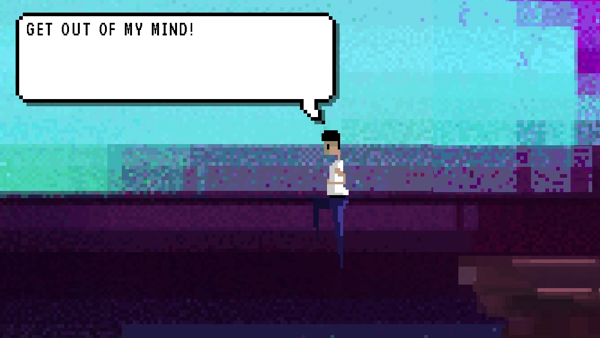
It’s sort of similar to other subversive games previously discussed in this space, but it’s much less successful as a deconstruction. Rather than showing the effects of video game assumptions in a more realistic world to highlight their implicit, absurd, or even irresponsible nature, The Journey of Me attacks the player for following video game assumptions in what is very obviously a video game world. Act transitions are indicated with banners and signs, giant coins float in midair and can be collected by touching them, mindless creatures block your path and must be killed to proceed.
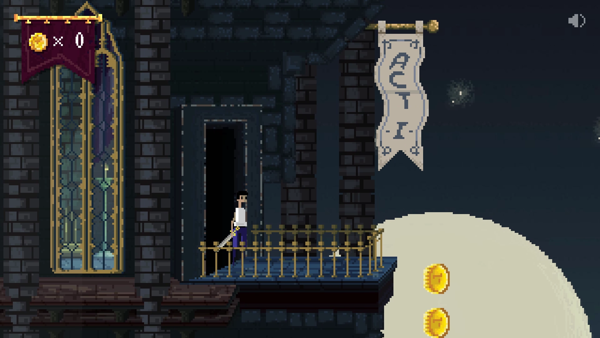
The only objections are voiced by the player character, and despite the fact that he clearly occupies a world designed to constrict him and the player to a single path, he says nothing about the designer and reserves all his hate and vitriol for the player. He refers to the player as “the sick prick who turned [him] into a psychopath” when the designer is the one who put him in a world where psychopathy is the only real option.
To be fair to the creators, The Journey of Me is a polished-up student project and they recognize that it’s flawed. But I’m not sure they understand the flaws. The game was originally intended to “provide the player with multiple choices and the corresponding hero’s reactions” but this was cut for a few reasons - however, what’s left is a game where “the hero is mad at the player & insulting him, and…the player can’t actually do anything about it…” When choice is taken away from the player, the game is no longer about the player, but The Journey of Me doesn’t acknowledge this. The player character’s dialog still assumes the player’s actions reveal something meaningful about them and the game’s subtitle is even “A GAME ABOUT YOU”!
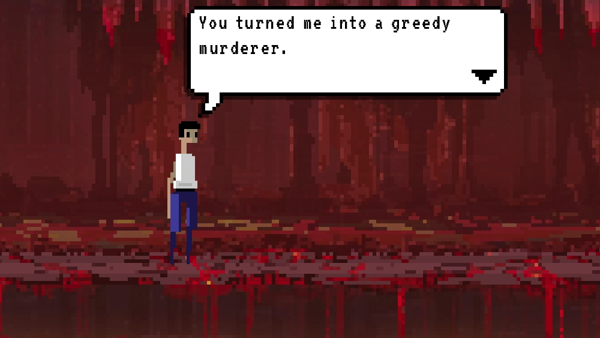
The Journey of Me is thus quite frustrating to play. It accuses the player of all sorts of terrible personality flaws for taking actions that are required by the game’s design. The only way these actions could say less about the player is if the game were a movie instead.
This is an extreme example, but the underlying misunderstanding is common. It’s all too easy to treat gameplay as a dialog between the player and the game, when really it’s a dialog between the player and the designer. The dialog is mediated by the game - but only in the ways chosen by the designer. Players do not reveal themselves by choosing from an unlimited range of naturally-occurring optional actions - the designer determines the set of available actions and how allowed each action is. The further toward either end of the spectrum of allowance any action is placed, the more aggressively the game encourages or discourages it, and the less free is the player’s choice whether to take that action - because the choice is increasingly made by the designer.
Most of the time, this is all for the player’s benefit, constraining their available actions to what’s interesting and enjoyable. It’s normal and expected for a game’s world to be designed for the player. But what about when that world is inhabited by NPCs whose own choices are also constrained by the game’s design?
“…one of my biggest concerns around creating a romance game is how to deal with consent when NPCs are programmed to say ‘yes’. . . . I feel there are meaningful solutions, but I’m definitely interested in hearing thoughts or examples on other ways to better model consent."
—Lynnea Glasser, Potential Future Romance Games? (Creatures)
Lynnea Glasser wrote the above in a blog post about her game Creatures Such as We, which raises the question of whether dating games send the wrong message about consent. Although it does not provide a definitive answer of its own, Creatures Such as We does feature optional romance and thus forces the player to confront the issue to some degree.
“The most thought provoking question Glasser presented in my play through was ‘Can non-playable characters give consent?’, which resulted in an almost gut wrenching feeling for me playing through the game. Was it wrong of me to want to engage with an NPC in a game that is designed to run like a dating simulator? Should a game, that is all about coming to the right response to get to the right ending be allowed to say ‘no’ to my wishes? Games of course are not people, but it’s interesting to consider, am I as the player entitled to getting the ending of my dreams, or is the game and in turn the game designer allowed some agency of choice as well?
Glasser gives no clear answers to the philosophical question she raises in gameplay, however I began to see the choices she allows you as the player becoming a sort of answer for players. As the game and narrative progresses, you can choose to continue engaging with the non-playable character you have established some romantic feelings for. Alternatively, you can choose draw back into your tour guide responsibilities and become cold to the romantic interest and the group around you. It’s as if you turning away from the romantic interest allows the non-playable character to say no, despite that response never being given to them."
—Emily Pilat, Get Meta: Can a Game Give Consent?
But backing away from romance doesn’t allow the NPC to say no - if anything, it forces them to. Whether the player chooses to pursue a romance or avoid it, the NPC has no say in the matter. The NPC cannot choose whether to reciprocate the player’s advances or whether to approach the player themselves. But those choices aren’t up to the player either - they were already made by Glasser. The player only chooses between the options that the game makes available, and the NPCs follow the corresponding prewritten script. The designer is still in charge.
Some games make an explicit attempt to model NPC consent. Robert Yang’s Hurt Me Plenty is “a short game where you spank the heck out of a dude and learn about how BDSM communities attempt to formalize consent / caring”. But even here, consent is simplified and far looser than in real life. If you violate your partner’s trust, you can always regain it by simply waiting.
“If you mistreat this AI agent, it will render itself inoperable and refuse to play with you for a period of time, ranging from 2-20 days. . . . The game should, ideally, refuse to play with you ever again, when you violate negotiated boundaries. As it stands now, it will always ‘forgive’ you after a while."
—Robert Yang, Notes on sex, consent, and intimacy in games and tech
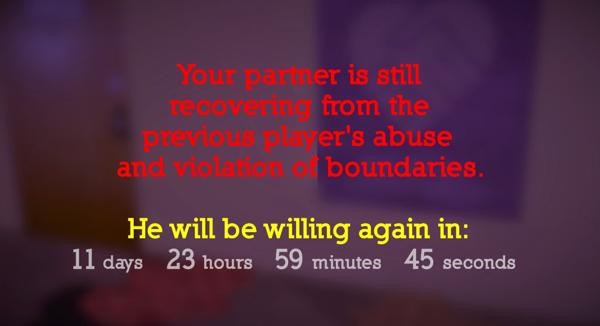
Of course, it’s not really feasible for a game to refuse to ever play again anyway. Saved data could be manipulated to clear the relevant flag or the game could simply be reinstalled. The game can appeal to your sense of guilt or shame, but it’s not a person. No one’s really been hurt and the game can’t take out a restraining order or press charges.
This is an important point. The entire purpose of consent in real life - the reason it matters at all - is the real person on the other side of the interaction. A real mind with real desires and fears as well as actual moral and legal standing. NPCs have none of these - but the designer has them all. And as the person who lays down the rules of the universe in which the game characters live, the designer’s consent completely overrides that of the NPCs. Yang chose to allow players to violate their partner’s consent in Hurt Me Plenty. He didn’t have to. The action could have been prevented completely or rendered ineffective; instead it is merely punished. The player is still allowed to do it, regardless of what the NPCs themselves would prefer - and this was a choice made by Yang. The designer is still in charge.
To be clear, there wasn’t anything immoral about Yang’s choice. He chose not to protect the NPCs, but there isn’t really anything there to protect. They aren’t people. The value of getting the player to consider the consequences of their actions outweighs the damage done to the NPCs by those actions - because no damage was actually done.
But surely the same logic should then apply to the player? It’s not immoral for the player to hurt the NPCs either, because nobody actually gets hurt. It comes down to the same problem that exists with The Journey of Me: either the player is innocent, or the player is complicit but the designer is the real monster.
Okay, so if predefined paths and binary responses are the designer overriding the NPC’s consent, what if we systematize further? What if we give characters fleshed-out personalities and preferences, and let their feelings for the player character change naturalistically based on the player’s choices?
Arguably, this is even worse. The more systematized a character is, the more the player is encouraged to treat the NPC as a system to be gamed rather than a person.
Beautiful Escape: Dungeoneer is a game where you play as a serial killer who tortures victims in a trap-laden dungeon. Setting up the dungeon plays like a tower defense puzzle, but first you have to find your victims, which is handled differently. By the game creator’s own description, this gameplay “is similar to a Dating Sim, in which you have to approach strangers on the street and seduce them to go home with you, mainly using dialog choices.” You’re presented with a paragraph describing your target and must work out how to win their trust.
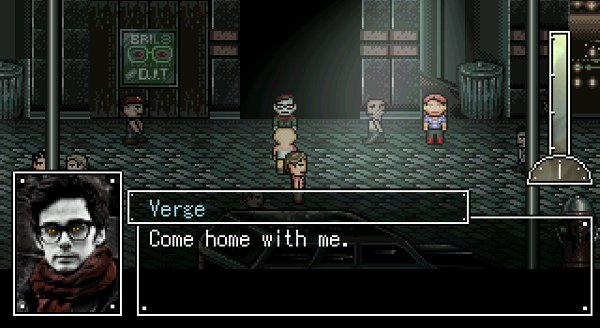
The end goal may be horrifying, but the way you get there is fundamentally the same thing you do in any game with an affection system. You don’t act in a way authentic to yourself or to your character. You do and say what’s necessary to get what you want. Beautiful Escape: Dungeoneer lays it bare by attaching the process to a heinous and evil outcome, but it’s the same process in other games even if you’re just trying to make friends with your party members.
“Beautiful Escape: Dungeoneer has some of the most compassionate dialogue options of any game I’ve played, perversely appropriate for the psychopathic protagonist. This is a game in which you lure innocent strangers to your basement to be tortured to death, but it’s also a damning critique of how video games use dialogue to represent relationships. . . . Kieron Gillen described the conversations systems best in Beautiful Escape and dating sims in general as ‘about hiding the self to gain what you want, and that’s all these games boil down to,’ which is a literal symptom of sociopathy.
Beautiful Escape treats conversations like an interpersonal quiz show. . . . Is this, then, any different from Dragon Age Origins, in which the damage bonus or special quest or sex scene is your reward? It’s not just that the reward is cynical, it’s the method of obtaining it. …[P]arty members are supposed to be the player’s friends and allies, and friendship is supposed to come with honesty and empathy.
Yet conversations in this game encourage players to say whatever will (literally) score them the most points with their in-game friends. Even if players are motivated by nothing more than a genuine interest in the character, the game system still rewards manipulative dialogue (at best, when it isn’t a random guessing game). That’s not how friendship is supposed to work. Friends fight and argue and make up. Friends disagree with each other. Friends aren’t supposed to keep score. They’re supposed to say what they feel, not what they think their friend wants to hear."
—Andrew Vanden Bossche, Analysis: Game Dialogue As A Recipe for Sociopathy
This doesn’t just apply to dialog choices. Attempts to model consent are doomed to fail by definition. A model is a set of manageable rules with minimal external consequences. A game can obscure the rules, hiding affection levels and not making it obvious when a decision has an impact on how NPCs see you, but as long as a player can look on GameFAQs or engage in save scumming, the game can still be played as a sociopathy simulator. It’s a social uncanny valley effect - the more realistically the relationship and interactions are portrayed, the more the player’s actions resemble those of a sociopath in the real world. After all, sociopathy is essentially treating others as though they are inhuman with no moral value of their own and exist for your own benefit - and for NPCs, that’s actually true.
The more scripted, prewritten, or constrained a game’s world is, the more the voice of the designer overrides the voice of NPC and player alike, and the less freedom either has. But the more systematized the world is, the more free the player is to manipulate that world and the NPCs as they desire. The NPCs never hold the power, because they are not people - but by the exact same token, it doesn’t matter that they have no power. As long as we’re talking about single-player and no other people are involved, you aren’t hurting anyone no matter how you play.
It can be tempting to extrapolate from fiction to reality and conclude that a player who treats NPCs poorly or a designer who lets them is automatically a bad person. But this is simply not true. Just as it’s completely possible to play violent games and remain non-violent, it’s completely possible to trample all over the consent or desires of NPCs and still be someone who treats actual people with kindness and respect.
“[W]hether it is wrong to sadistically mistreat inanimate objects or video game characters or stuffed animals or whatever depends tremendously on you as an individual.
There are people who that kind of behavior is unhealthy for. There are people who find that inhabiting an unkind version of themselves, imagining an inanimate object as capable of suffering and then inflicting harm on it for fun, isn’t great for them, and leaves them less the person they want to be, and exacerbates tendencies that aren’t helpful to them in their interaction with other, real people. I assume that the people who are asserting it is inherently wrong to mistreat objects are people who have this experience, and they’re probably not wrong about what’s healthy for them, they’re just overgeneralizing. . . .
And if you play a tyrannical monster in video games, or strand your Sims in the swimming pool because it’s fun to watch them drown, or beat up pieces of plastic while imagining they’re your terrible ex, […] or otherwise love to do things that are normally terrible because they harm people, but that, in this case, involve no people -
- well, I think it’s really important to trust yourself. The question ‘is this harming me? is this making me less someone I want to be?’ is an important question, but only you can answer it, and you shouldn’t answer it from broad pronouncements that certain categories of activity are definitely in the ‘Wrong’ category. And if it’s not harming you, and it’s fun, then it’s actively a good and moral thing to do, because your happiness is good and your fun is good and the only moral wrongs are harms to beings, and you are the only being in this story.
And if it is harming you - then stop, but please keep in mind that the harm was a product of your specific interaction with this specific activity, and that what was unhealthy and unvirtuous for you is guaranteed to be healthy, virtuous, value-affirming and fun for lots of other people."
—The Unit of Caring post from 8 May 2018
Games are fiction. They take place in invented worlds. The designer decides all the terms of the player’s interaction with the game and its characters - but by the same token, no actual harm can occur within them. There’s nothing inherently wrong with pretending to slay imaginary dragons, date imaginary people, or even torture and murder imaginary victims (though personally I prefer to skip that last one).
As is always the case, the key is to be mindful of what you’re doing, why you’re doing it, and the effect it has on you. But you can only answer this for yourself. This decision is one the designer can’t make for you.